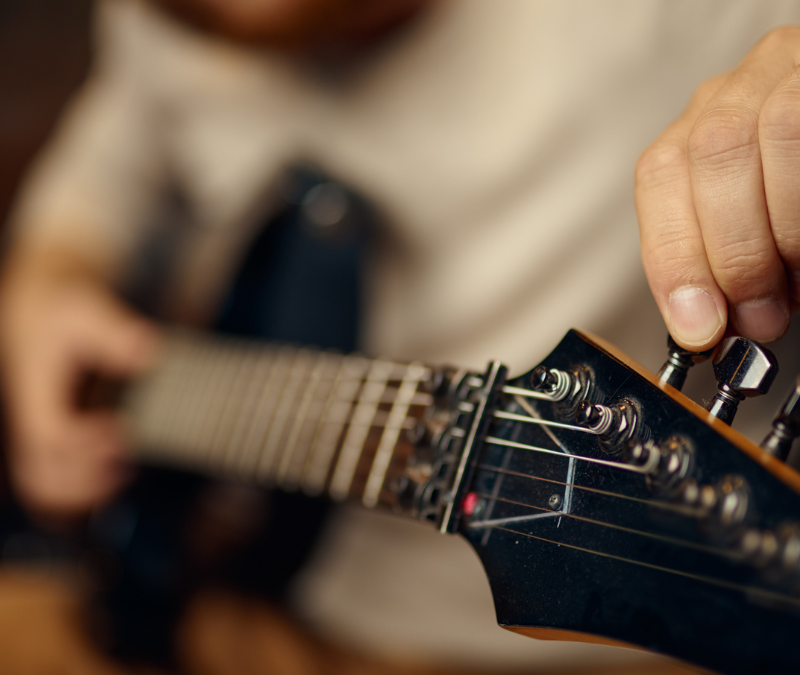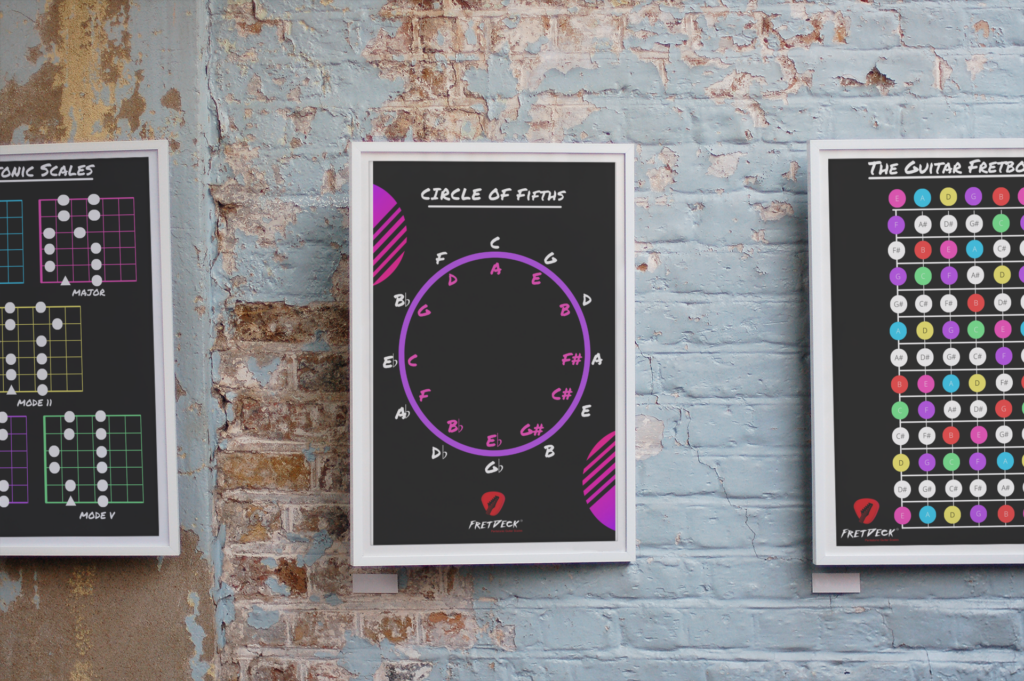Have you ever found yourself without a tuner, stuck with a guitar that sounds just a little… off? Learning how to tune a guitar by ear is one of the most valuable skills you can develop as a guitarist. It sharpens your ears, strengthens your musical instincts, and connects you more deeply to your instrument. But let’s face it—tuning by ear can feel intimidating if you’re used to relying on apps or digital tuners.
Here’s the good news: tuning by ear isn’t as hard as it sounds. With a little practice (and the right tools), you’ll be able to tune your guitar quickly and confidently anywhere, anytime. In this post, I’ll walk you through how to tune a guitar by ear step-by-step and show you how tools like FretDeck can make mastering this skill even easier.
Why Learn How to Tune a Guitar by Ear?
Let’s start with a question: why even bother learning how to tune a guitar by ear when tuners exist? After all, technology makes tuning fast and easy, right?
True—but here’s what those little gadgets don’t tell you:
- Tuning by ear trains your musical ear. It helps you develop the ability to hear subtle differences in pitch, which is essential for playing in tune, improvising, and even singing.
- It connects you to your instrument. When you tune by ear, you’re engaging with the physical vibrations of your strings and the sound they produce. This helps you build a deeper relationship with your guitar.
- You’ll never be stuck. Whether you’re jamming with friends, playing on stage, or hanging out at a campfire, you’ll always be ready to tune up—no gadgets required.

Download The FretDeck & Pentatonic Secrets Course!
Download Our Course
The Basics of How to Tune a Guitar by Ear
To tune a guitar by ear, you’ll need a reference note for your low E string (the thickest string). This can come from another instrument, a tuning fork, a smartphone app, or even your voice if you know the pitch. Once your low E is in tune, you can tune the rest of your strings relative to it.
Here’s the step-by-step process:
1. Tune the Low E String to a Reference Note
- Find a reference note for your low E string. This could be a piano, another guitar, or a pitch generator app.
- Pluck the low E string and compare it to the reference note.
- Adjust the tuning peg until the pitch matches.
Pro Tip: Use your ears, not your eyes. Listen for when the two pitches “blend” and no longer sound dissonant.
2. Tune the A String
- Place your finger on the 5th fret of the low E string. This produces an A note.
- Pluck the 5th fret note and the open A string together.
- Adjust the A string’s tuning peg until the two notes match.
3. Tune the D String
- Place your finger on the 5th fret of the A string to produce a D note.
- Pluck the 5th fret note and the open D string together.
- Adjust the D string’s tuning peg until the pitches match.
4. Tune the G String
- Place your finger on the 5th fret of the D string to produce a G note.
- Pluck the 5th fret note and the open G string together.
- Adjust the G string’s tuning peg until they sound the same.
5. Tune the B String
- Place your finger on the 4th fret of the G string (not the 5th this time). This produces a B note.
- Pluck the 4th fret note and the open B string together.
- Adjust the B string’s tuning peg until they match.
6. Tune the High E String
- Place your finger on the 5th fret of the B string to produce an E note.
- Pluck the 5th fret note and the open high E string together.
- Adjust the high E string’s tuning peg until they’re in tune.
How to Check Your Work
Once you’ve tuned all the strings, it’s time to double-check:
- Play some chords. Strum simple chords like G, C, or D. If the chords sound off, one or more strings might need fine-tuning.
- Harmonics tuning. Lightly touch the 5th fret of the low E string and pluck the harmonic. Do the same on the 7th fret of the A string. These should match. Repeat this for the A-D, D-G, and G-B strings.
- Listen for dissonance. If two notes sound like they’re “wobbling” against each other, the strings are slightly out of tune.
Tips for Mastering How to Tune a Guitar by Ear
Tuning by ear is a skill that gets better with practice. Here’s how to improve:
1. Practice Regularly
Start every practice session by tuning your guitar by ear. Over time, your ear will get sharper, and the process will feel more natural.
2. Use Reference Tracks
Play along with well-tuned tracks or recordings to train your ear to recognize correct pitch.
3. Use Tools to Train Your Ear
Apps and flashcards designed to improve pitch recognition can be incredibly helpful. (More on this in a second.)
How FretDeck Can Help You Tune Your Guitar by Ear
Let’s be honest: learning how to tune a guitar by ear can feel daunting at first. That’s where FretDeck comes in.
FretDeck is more than just a practice tool—it’s your personal guide to mastering the fretboard, developing your ear, and building confidence as a guitarist. Here’s how it helps:
- Interactive Flashcards: FretDeck includes exercises designed to train your ear to recognize notes and intervals, making tuning by ear much easier.
- Visual Aids: The scale diagrams in FretDeck help you understand how notes relate to each other, so you can navigate the fretboard with ease.
- Step-by-Step Lessons: From tuning tips to advanced fretboard knowledge, FretDeck breaks everything down into simple, actionable steps.
Whether you’re just starting out or looking to take your skills to the next level, FretDeck is the perfect companion.

Download The FretDeck & Pentatonic Secrets Course!
Download Our Course
Common Tuning Mistakes (And How to Avoid Them)
When learning how to tune a guitar by ear, it’s easy to make a few missteps. Here’s what to watch for:
1. Over-Tightening Strings
New players often turn the tuning pegs too far, risking string breakage. Adjust slowly and listen carefully.
2. Ignoring String Age
Old strings don’t hold pitch well. If your guitar sounds off even after tuning, it’s probably time for a new set.
3. Relying Only on Visuals
Don’t just watch your fingers—train your ears to recognize when two notes match.
Why Learning to Tune by Ear Matters
Think about this: when you can tune a guitar by ear, you’re not just learning a skill—you’re building a deeper connection with your instrument. You’re developing a sharper ear, a better sense of pitch, and the ability to adapt in any musical situation.
Your Next Step: Grab FretDeck and Master Tuning
Ready to make tuning by ear second nature? With FretDeck, you’ll not only learn how to tune a guitar by ear—you’ll unlock the full potential of your instrument.
Here’s what you’ll get with FretDeck:
- A complete system for mastering the fretboard.
- Exercises to train your ear and improve your pitch recognition.
- Easy-to-follow diagrams and lessons that simplify guitar playing.
Click Below to Get Your FretDeck Now:
Buy FretDeck Today
Final Thoughts: How to Tune a Guitar by Ear Like a Pro
Learning how to tune a guitar by ear is one of the most rewarding skills you can develop as a guitarist. It not only makes you a better player but also deepens your connection with your instrument and music.
With the step-by-step method outlined here—and the help of FretDeck—you’ll be able to tune confidently and play beautifully, no matter where you are.
So what are you waiting for? Grab your guitar, tune it up, and start playing. And don’t forget to download FretDeck to supercharge your progress!
For more insights on developing your ear and improving your guitar skills, check out our article on Guitar Tips for Beginners: Avoid These 7 Common Mistakes. This resource offers practical advice to help you avoid common pitfalls and enhance your playing.

Join Guitar Freaks Hangout on Discord! 🎸
Get Fret Logic FREE!
Join the Guitar Freaks Hangout Discord and get exclusive access to my entire e-book, Fret Logic! Master the fretboard and elevate your solos with this comprehensive guide.
👉 Don’t miss out—join now and download your free copy!










